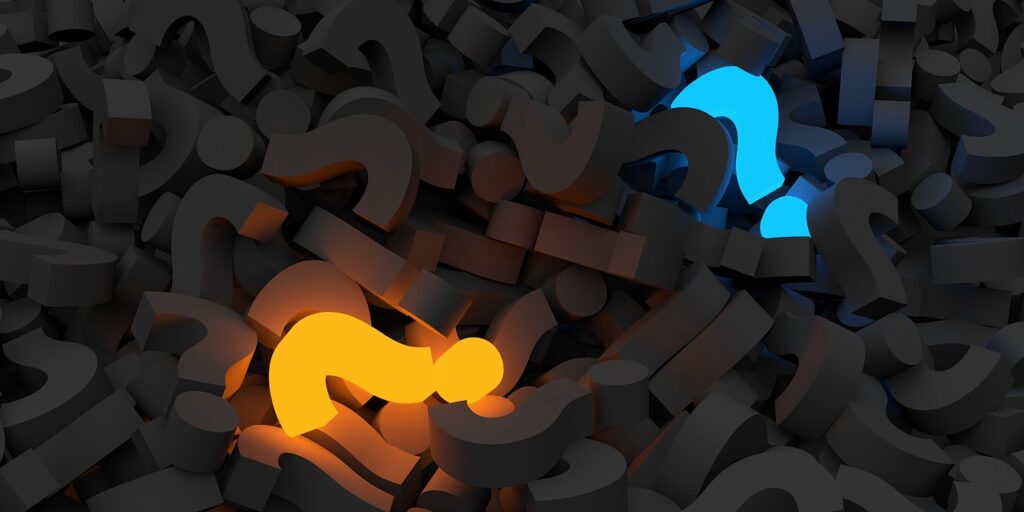Questions on Entropy
Q1. What is the relationship between entropy and information in information theory? Can you give an example to illustrate this concept?
Example: In a coin toss, if the coin is fair (i.e., the probability of getting heads or tails is 0.5), the entropy is 1 bit, which means that one bit of information is needed to represent the outcome of the coin toss.
Q2. What is the maximum possible entropy for a given set of events? Can you give an example to illustrate this concept?
Example: A die has six possible outcomes, each with a probability of 1/6. The maximum possible entropy is log2(6) ≈ 2.58 bits, which means that at most 2.58 bits of information are needed to represent the outcome of rolling the die.
Q3. How does entropy relate to the amount of uncertainty in a system? Can you give an example to illustrate this concept?
Example: A deck of cards has 52 possible outcomes, each with a probability of 1/52. The entropy of the deck of cards is log2(52) ≈ 5.7 bits, which means that there is a high degree of uncertainty in predicting the outcome of drawing a card from the deck.

Q4. Can entropy be negative in information theory? Can you give an example to illustrate this concept?
Example: Entropy cannot be negative in information theory, as it represents the amount of uncertainty or randomness in a system. If the probability of an event is zero, the entropy is also zero, and if the probability of an event is one, the entropy is also zero.
Q5. How does the concept of entropy relate to data compression? Can you give an example to illustrate this concept?
Example: Data compression algorithms use the concept of entropy to identify patterns in data and represent them more efficiently. For example, if a file contains a lot of repeated patterns, a compression algorithm can represent those patterns with fewer bits, resulting in a smaller file size.
Q6. What is the entropy of a fair coin toss?
Solution:
The entropy of a fair coin toss can be calculated as follows:
- There are two possible outcomes (heads and tails) with equal probability (0.5 each).
- The entropy is given by H = -0.5log2(0.5) – 0.5log2(0.5) = 1 bit. Therefore, one bit of information is needed to represent the outcome of the coin toss.
Q7. A deck of cards contains 26 red cards and 26 black cards. What is the entropy of drawing a card from the deck?
Solution:
The entropy of drawing a card from the deck can be calculated as follows:
- There are two equally likely outcomes (red or black), with probabilities of 0.5 each.
- The entropy is given by H = -0.5log2(0.5) – 0.5log2(0.5) = 1 bit. Therefore, one bit of information is needed to represent the outcome of drawing a card from the deck.
Q8. A communication channel can transmit 1000 bits per second. If the entropy of the source is 2.5 bits per symbol, what is the maximum symbol rate that can be transmitted over the channel?
Solution:
The maximum symbol rate that can be transmitted over the channel can be calculated as follows:
- The channel can transmit 1000 bits per second, so the maximum number of symbols that can be transmitted per second is 1000/2.5 = 400 symbols per second.
Q9. A binary data source generates symbols with probabilities p(0) = 0.8 and p(1) = 0.2. What is the entropy of the source?
Solution: The entropy of the binary data source can be calculated as follows:
- There are two possible symbols (0 and 1), with probabilities of 0.8 and 0.2, respectively.
- The entropy is given by H = -0.8log2(0.8) – 0.2log2(0.2) = 0.72 bits per symbol.
Q10.A message consisting of 1000 symbols is encoded using a variable-length code with average codeword length L = 2.5 bits per symbol. What is the minimum possible entropy of the source that generated the message?
Solution:
The minimum possible entropy of the source that generated the message can be calculated using the following formula: H >= (1/L) * n * log2(m), where n is the number of symbols in the message, m is the size of the alphabet, and L is the average codeword length.
- In this case, n = 1000 and L = 2.5, so we have H >= (1/2.5) * 1000 * log2(m).
- If we assume that the source is binary (i.e., m = 2), then we get H >= 400 bits. Therefore, the minimum possible entropy of the source is 400/1000 = 0.4 bits per symbol.
Q11. Explain the concept of entropy in information theory and how it relates to the amount of uncertainty in a system. Provide an example to illustrate your answer.
Solution:
In information theory, entropy is a measure of the amount of uncertainty or randomness in a system. It represents the minimum number of bits of information needed to represent the outcomes of a random process. The higher the entropy, the more uncertain or unpredictable the outcomes of the process are.
For example, consider a coin toss. If the coin is fair (i.e., the probability of getting heads or tails is 0.5), the entropy is 1 bit, which means that one bit of information is needed to represent the outcome of the coin toss. On the other hand, if the coin is biased towards heads (i.e., the probability of getting heads is 0.8), the entropy is 0.72 bits, which means that less than one bit of information is needed to represent the outcome of the coin toss, as the outcome is more predictable.
Q12. Define the maximum entropy for a given set of events and explain how it can be calculated. Provide an example to illustrate your answer.
Solution:
The maximum entropy for a given set of events is the entropy that would be achieved if all the events were equally probable. It represents the highest degree of uncertainty or randomness that is possible for the given set of events. The maximum entropy can be calculated using the formula:
Hmax = log2(m)

where m is the size of the alphabet (i.e., the number of possible outcomes). If all the outcomes are equally probable, then the probability of each outcome is 1/m, and the entropy is given by:
H = -Σp(x)log2p(x)
where p(x) is the probability of outcome x. The maximum entropy is achieved when p(x) = 1/m for all x, and is given by:
Hmax = -Σ(1/m)log2(1/m) = log2(m)
For example, consider a fair six-sided die. The size of the alphabet is m = 6, and each outcome is equally probable, so the maximum entropy is Hmax = log2(6) ≈ 2.58 bits. Therefore, at most 2.58 bits of information are needed to represent the outcome of rolling the die.
Q13. Explain the relationship between entropy and data compression. Provide an example to illustrate your answer.
Solution:
Entropy and data compression are closely related in information theory. The entropy of a source represents the minimum number of bits of information needed to represent the outcomes of a random process. Data compression algorithms use the concept of entropy to identify patterns in data and represent them more efficiently. If a file contains a lot of repeated patterns, a compression algorithm can represent those patterns with fewer bits, resulting in a smaller file size.
For example, consider a file containing the sequence “ABABABABAB”. The entropy of this sequence is 1 bit per symbol, as there are only two possible symbols (A and B) with equal probability. However, if we use a simple compression algorithm that replaces each repeating pattern with a single symbol and a count (e.g., “A5B5”), we can reduce the file size by half without losing any information. This compression algorithm is based on the fact that the entropy of the sequence is low due to the repeating patterns, and therefore the sequence can be compressed efficiently.
Q14. Explain the concept of conditional entropy and provide an example to illustrate your answer.
Solution:
Conditional entropy is a measure of the amount of uncertainty in a system given some additional information. It represents the minimum number of bits of information needed to represent the outcomes of a random process, given that we know the outcome of another random process. The conditional entropy is calculated using the formula:
H(Y|X) = -ΣΣp(x,y)log2p(y|x)
where p(x,y) is the joint probability of events X and Y, and p(y|x) is the conditional probability of event Y given event X.
For example, consider a deck of cards. If we draw a card at random, the entropy is H(X) = log2(52) ≈ 5.7 bits, as there are 52 possible outcomes with equal probability. However, if we know that the card drawn is a face card (i.e., a Jack, Queen, or King), the entropy is reduced, as there are only 12 possible outcomes. The conditional entropy of the suit of the card (event Y) given that it is a face card (event X) can be calculated using the formula:
H(Y|X) = -ΣΣp(x,y)log2p(y|x)
= -(1/4)log2(1/3) – (1/4)log2(1/3) – (1/4)log2(1/3) – (1/4)log2(1/3)
= 1.58 bits
This means that if we know that the card drawn is a face card, we only need 1.58 bits of information to represent the suit of the card.

Q15. Explain the concept of joint entropy and provide an example to illustrate your answer.
Solution:
Joint entropy is a measure of the amount of uncertainty in a system that involves two or more random variables. It represents the minimum number of bits of information needed to represent the outcomes of the joint distribution of the variables. The joint entropy is calculated using the formula:
H(X,Y) = -ΣΣp(x,y)log2p(x,y)
where p(x,y) is the joint probability of events X and Y.
For example, consider a game of rock-paper-scissors. If two players each choose one of the three options with equal probability, the joint entropy is H(X,Y) = log2(9) ≈ 3.17 bits, as there are nine possible outcomes of the joint distribution with equal probability. The joint entropy can also be calculated using the individual entropies of the variables and the conditional entropy, using the formula:
H(X,Y) = H(X) + H(Y|X)
= log2(3) + H(Y|X)
where H(Y|X) is the entropy of variable Y given the value of X.
For example, if we know that one player chooses rock, the conditional entropy of the other player’s choice (variable Y) given the value of X is H(Y|X) = log2(3) ≈ 1.58 bits, as there are three possible outcomes with equal probability. Therefore, the joint entropy is:
H(X,Y) = log2(3) + log2(3) ≈ 2.58 bits
This means that if we know the value of one variable (e.g., one player’s choice), we can reduce the entropy of the joint distribution and represent the outcomes with fewer bits.
Q16. Define the concept of mutual information and provide an example to illustrate your answer.
Solution:
Mutual information is a measure of the amount of information that two random variables share. It represents the reduction in uncertainty of one variable given knowledge of the other variable. The mutual information between two variables X and Y is defined as:
I(X;Y) = H(X) – H(X|Y) = H(Y) – H(Y|X)
where H(X) and H(Y) are the individual entropies of variables X and Y, and H(X|Y) and H(Y|X) are the conditional entropies of X given Y and Y given X, respectively.
For example, consider a communication system that transmits a binary message over a noisy channel. The message can be either 0 or 1 with equal probability, and the channel introduces random errors such that the received message is incorrect with probability 0.1. The entropy of the transmitted message is H(X) = 1 bit. The entropy of the received message given the transmitted message is H(Y|X) = H(Y) – I(X;Y) = 0.468 bits. The mutual information between the transmitted message and the received message is therefore:
I(X;Y) = H(X) – H(X|Y) = H(Y) – H(Y|X) ≈ 0.532 bits
This means that knowing the value of the transmitted message reduces the uncertainty of the received message by 0.532 bits.
Q17. Explain the concept of channel capacity and provide an example to illustrate your answer.
Solution:
Channel capacity is the maximum rate at which information can be transmitted over a communication channel with a given noise level, while maintaining a desired level of reliability. It is a measure of the maximum amount of information that can be transmitted per unit time over the channel, measured in bits per second. The channel capacity is calculated using the formula:
C = B log2(1 + S/N)
where B is the bandwidth of the channel, S is the signal power, N is the noise power, and log2(1 + S/N) is the signal-to-noise ratio (SNR) of the channel.
For example, consider a communication system that transmits a binary message over a noisy channel with a bandwidth of 10 kHz. The noise power is -100 dBm/Hz, and the signal power is 0 dBm. The channel capacity is therefore:
C = 10,000 log2(1 + 0.1/0.0000000001) ≈ 33.22 kbps
This means that the maximum rate at which information can be transmitted over the channel with a desired level of reliability is 33.22 kbps. If the desired level of reliability is higher, the channel capacity will be lower.
Q18. Explain the concept of source coding and provide an example to illustrate your answer.
Solution:
Source coding, also known as data compression, is the process of representing a message in a more efficient form by reducing its redundancy. The goal of source coding is to reduce the number of bits required to represent a message, while minimizing the loss of information.
For example, consider a text document that contains 1,000 characters. Each character can be represented using 8 bits, which means that the document requires 8,000 bits to be transmitted. However, if the document contains a lot of repetition, it may be possible to compress it by representing each repeated sequence of characters using a shorter code.
One commonly used source coding technique is Huffman coding, which assigns shorter codes to frequently occurring symbols and longer codes to less frequently occurring symbols. For example, suppose that the document contains the following four characters: A, B, C, and D, with the following frequencies:
A: 300 B: 200 C: 150 D: 350
Using Huffman coding, we can assign the following codes to the four characters:
A: 0 B: 10 C: 110 D: 111
This means that the document can be represented using the following sequence of bits:
0 0 0 … (300 times) … 10 10 … (200 times) … 110 110 … (150 times) … 111 111 … (350 times)
The total number of bits required to represent the document using Huffman coding is:
300 x 1 + 200 x 2 + 150 x 3 + 350 x 3 = 1,700 bits
This is significantly less than the 8,000 bits required to represent the document using 8 bits per character.
Q19. Explain the concept of channel coding and provide an example to illustrate your answer.
Solution: Channel coding, also known as error-correcting coding, is the process of adding redundant information to a message to enable the receiver to detect and correct errors that occur during transmission over a noisy channel. The goal of channel coding is to increase the reliability of the communication system by reducing the probability of errors.
For example, consider a communication system that transmits a binary message over a noisy channel with a bit error rate of 10^-5. If the message is transmitted without any error correction, the receiver will detect an error on average once every 100,000 bits. However, if the message is encoded using a channel code, the receiver can detect and correct errors with a higher probability.
One commonly used channel coding technique is the Reed-Solomon code, which adds extra symbols to the message to enable the receiver to correct errors. For example, suppose that the message is a block of 256 bytes (2,048 bits), and the Reed-Solomon code adds an additional 32 bytes (256 bits) to the message. The resulting codeword is then transmitted over the channel.
If the receiver detects an error in the codeword, it can use the Reed-Solomon decoding algorithm to correct the error. The decoder assumes that up to 16 bytes (128 bits) of the codeword may be in error, and attempts to correct the errors using the redundant information in the codeword. If the number of errors is greater than 16 bytes, the decoder is unable to correct the errors, and the receiver must request retransmission of the message.
Using the Reed-Solomon code, the receiver can correct errors with a probability of 99.999%, significantly higher than the probability of error detection without any error correction.